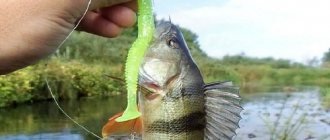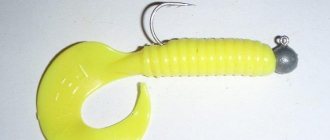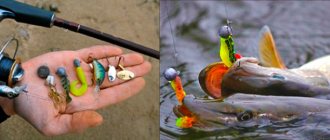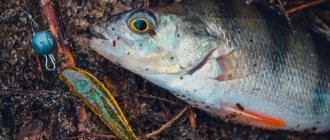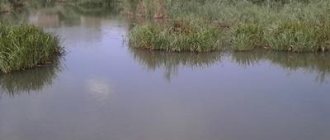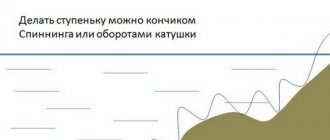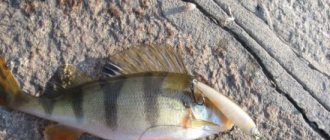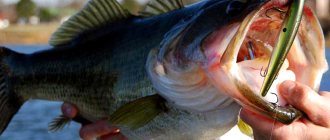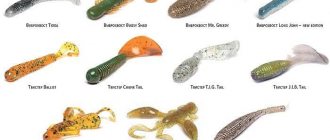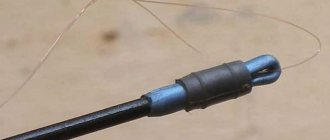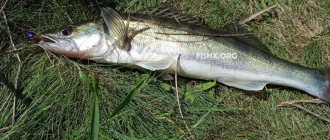No-hook jigs
The fish often stands in thick grass or snags where you can quickly run out of the entire day's supply of bait. In such cases, non-clinging options come to the rescue. But it should be said right away that this concept is rather arbitrary. Even such baits still sometimes get caught, get stuck in snags, between stones and break off. But this happens several times less often.
It is absolutely clear that any hook guards worsen hooking and the number of fish escapes increases significantly. Nevertheless, in many cases, “non-hooking” helps out.
Types of jig heads
All weight heads for spinning fishing can be divided into two types:
- combined with a hook;
- cast separately.
The simplest option is the head, cast together with the hook. Such models are usually called jig heads. They are large and heavy jigs, equipped with a ring and a lock. The ring is located at right angles to the fore-end, and the stopper prevents the soft bait from slipping and turning.
Jig head clamps can have the following types:
Non-snagging jig heads with safety lock
The best and most versatile option is a jig head with a snag-proof hook (Fig. 1). The fuse can be a wire or plastic mustache, a bundle of fiberglass, or a rubber ring.
Fig.1. Non-hooking jig heads: a) with a wire loop; b) with a plastic mustache; c) with a bundle of fibers; d) with a rubber ring.
Other models of jig heads are designed so that the hook is partially hidden in the body of the bait, and only the very tip of the sting sticks out. When the fish grabs and hooks, the bait should slide down and “release” the hook (Fig. 2).
Fig.2. Jig head “Slo-Poke”.
Silicone in snags. The best non-snag
Date: January 25, 2021 | 383
When fishing with a spinning rod in general, and when fishing with soft silicone baits in particular, the angler very often encounters snags, hooks on the bottom and in the water column. On the one hand, the angler is annoyed by snagging and losing bait on snags. On the other hand, he himself often looks for such rubble or individual snags, because... near them there is often a concentration of fish and many bites occur. You have to find a balance between the desire to catch a predator and the risk of getting caught. In this article I want to talk about the use of various installations of silicone baits in snag conditions. Determine the best non-snags , installations that best pass through rubble and avoid snags.
Snags can be very different in their essence, composition, and geometry. The presence of a current in this place greatly affects the danger of snags.
It happens that a snag is just a separate flooded tree , and only its trunk part (the branches were broken off by time, they rotted, or they were carried away along with the broken off top).
Such an obstacle at the bottom is very common. Predatory fish, pike, pike perch, large perch, love to stand behind such a log, under it.
Finding individual sunken trees like these and jigging them is a good way to get bites and catches.
Such a simple snag in its essence, however, not every jig installation will go through without getting caught.
So, the anti-champion, the worst installation in terms of non-clinging, should be recognized as a hinged installation based on a double or triple hook.
Only if such equipment passes exactly over the tree, there will be no snag. If contact happens, the probability of a hook, in my opinion, is at least 70-80%.
The hinged mounting with a single open hook has a slightly better non-clinging indicator. Simply due to fewer hooks...
Even a regular jig head passes through such places better. Although, she sits down very often. And for now we are considering the simplest type of snag...
Jig heads of different shapes have different driftwood penetration. Some are better at overcoming obstacles - others are very bad at it. Sometimes a jig head in the shape of a boot or a fish head works well on snags.
Installing such snags with a jig head, on which wire or line protection against snags is installed, works somewhat better. Such tricks work with individual snags, but in the rubble, in dense snags, they are practically useless.
In practice, with close to 100% non-clinging properties, any installations on an offset hook can jump over such logs.
Now let's go through more complex snags and see how things are there.
A snag can be a whole tree or bush, with branches and root system.
These can be entire rubble of sunken trees and individual branches. Such snags can be clearings, flooded at the bottom of reservoirs, or rubble caused by rivers. The formation of snags is always different. This makes them dangerous and interesting.
The snag can only be located at the very bottom, some fragments may be located in the thickness, or even come to the surface. Such multi-level thick snags are hell for a spinner. But, if you get creative, good trophies often await you there.
So, in dense snags, and even in the current, all the above-mentioned installations are simply no good. All that remains is to evaluate the offset hook and installations using it.
There is one interesting opportunity to catch snags by using spaced rigs, such as a diverting leash and a drop shot. The idea here is that the streamlined sinker will go along the bottom, and the bait with a hook will go higher. The main thing here is to know the snag well. And this will work if the driftwood, the blockage, is at the very bottom, without rising to the middle layers. If you guess the distance from the load to the place where the leash or drop-shot hook is attached, then you can fish the area without any hooks at all and lure out a predator stuck in the support. All that remains is the risk of getting the weight stuck among the branches. But this risk is much less than getting caught on a hook. And also, weights, especially homemade ones, are much cheaper than bait with a hook.
Such a spaced rig, like the Carolina one, is not very good in snags, because bait on a separate leash often gets caught in snags.
Not very thick snags can be easily overcome by hinged mounting based on an offset hook.
But, in thicker debris, the Cheburashka sinker very often gets jammed. And now we are coming to the moment to name the best setup for fishing among snags. The title of best hook-free bait in the section of fishing with silicone baits goes to Texas equipment.
The bullet-shaped weight, sliding along the leash, practically does not jam among the branches, and the offset hook most reliably avoids snags.
In order for the offset hook to fit better and hide in the body of the bait, it is desirable that it have a longitudinal groove, a cut on the back. Many models of modern edibles have it. So, there are no problems with this.
Naturally, in especially dense multi-tiered rubble and snags, even installations on offset hooks, even Texas, do not completely protect against snags. But, when compared with all other equipment, the loss of bait with this method is minimal.
Also, it should be noted that the lighter the bullet weight used for Texas installation, the better it passes obstacles at the bottom, snags. The same rule applies to all other installations. Lighter load means fewer snags.
So, we can summarize. , Texas equipment is best suited . For bold fishing of single snags and flooded tree trunks, you can use it, or at least a hinged rig with an offset hook. Depending on the situation, you can bypass the snags using a drop-shot or a lead leash. And all other installations with open hooks are normal solutions for more or less clean areas of the bottom.
Share with your friends:
Categories: Edible fishing Tags: Snags, Installation, Unhooked, Lures
Lightweight, snag-free hooks and rigs
There are also lightweight non-snagging rigs for the upper and middle layers of water (Fig. 3). They require special hooks - thicker and heavier, which are thrown further and do not tip over when retrieving. The twisters and narrow “fish” themselves should be soft, even better without torque – (“frog” or “cuttlefish”), because with an excessively hard twister and a light hook, the bait can “go into a tailspin.”
Fig.Z. Lightweight non-snagging rigs for top layers: a) non-snagging hook; b) “offset” hook; c) a hook with a corkscrew; d) loaded hook with a corkscrew.
For pike, a strong tungsten or braided leash is required. When cast horizontally, such top-mounted rigs give an even better effect than a “banjo-minnow,” because the hook here is hidden in the middle of the bait, where the predator most often “hits.”
Types of non-hooking hooks for pike and their features
Today, there are several types of non-hooking baits that allow you to fish the most inaccessible and, as a rule, very promising areas of reservoirs. These are non-hooking lures for pike, various jig baits and unloaded silicone with a hidden hook point, spinnerbaits and gliders.
Non-snagging spinners
Oscillators with wire protection are simple and affordable. The hook is protected by antennae made of thin wire, the fish grabs the spoon, the antennae compress and the sting opens.
Combined non-clinging vibration oscillator with twister attachment
- non-hooking spinners for pike are used with a single, double or triple hook;
- passes through thick algae, snags and other obstacles without snagging;
- simple protection, easy to make yourself.
Magnetic protection is only possible on oscillating spoons. A magnet and a single hook are installed on them. After a predator attacks, the sting sticks into its mouth. Advantages of magnetic tackle:
- Pike fishing is possible in reservoirs with dense vegetation;
- The hook on the spoon is not tightly secured, so the percentage of bites is high.
Sometimes craftsmen can find interesting hand-made non-hooking spinners for pike.
No-hook jigs
Those who love jig fishing use silicone baits on an offset bait: twisters, vibrotails, slugs. The hook is hidden in silicone, so this gear is not afraid of any obstacles. The predator's bite crushes the soft material and the hook is released. Offsets are sold in stores, so you can make a non-hooking jig with your own hands.
The first non-snagging jig baits invented by anglers were foam fish with a double. In them, the hook fits tightly to the bait and does not interfere with movement. The pike grabs the fish, the foam shrinks, and the predator becomes prey.
Unloaded tires
In addition to the classic jig, you can also catch pike using unloaded rubber with a hidden offset hook. For this, all kinds of silicone baits are used, but without the front part, which allows them to be carried along the surface of the grass.
Removable non-snagging safety on the jig head
The option with a branch pushed the inventors to another version, when the protective element of transparent plastic is made separately and fits on any jig head of a suitable size (Fig. 5). This idea is the most practical: the fuse can be used with any bait, and can be easily removed if necessary. A few of these “shoots” are enough, and you don’t have to worry about snags. But while these “bells and whistles” are not available to us, we can only try to make something similar ourselves, for example, from tubes for droppers.
Fig.5. Removable plastic fuse: a) general view; b) mounting on a jig head.
In any case, you will definitely need some kind of “non-snag.” It often happens that a lazy pike stands among the thick grass, shows itself, plays, but you can’t get a regular bait through the grass, but it’s easy to get a “non-hooking” bait! Use this chance, and your catch will become more significant, and most importantly, you will learn to fish in more difficult non-standard conditions.
Non-hooking in jig fishing with silicone bait
The jig fishing method is 90% fishing with silicone bait and 10% foam fish. A twister or vibrotail is traditionally used as a soft, silicone bait, and much less often, some kind of creature (crustaceans, mollusks, etc.).
The options for installing a vibrating tail determine how vulnerable this equipment will be to snags and other water obstacles. Traditionally, two types of installation are most popular:
- jig head
- lead weight, for example, a Cheburashka and an offset hook, plus a vibrating tail/twister or something similar
Initially, at the dawn of Russian spinning anglers’ passion for jigs, it was the jig head that predominated in the equipment. Although, even now there are fans of this installation option. There are many reasons for this, the main one being ease of use. Take a vibrating tail, attach it and go ahead, cast and catch fish. But there is a serious problem here. If the place where you are going to fish is snagged, then the open hook, on the very first cast, will stick into some branch sticking out under the water and everything will break.
Naturally, no one liked these cliffs. After all, the jig head itself and the vibrating tail/twister cost money, and a fishing trip can cost you fifty. This is where experiments began with designs to protect the hook. They came up with everything they could think of: wire mustaches, and the same ones, but made from fishing line. But, through the efforts of the famous Russian spinning player Konstantin Kuzmin, the “oblique” installation of a jig head began to be used.
In this case, the soft bait is attached so that the body of the twister or vibrotail becomes at an angle of 45 degrees to the forearm, and the sting is hidden inside the bait. Such equipment becomes unhooked. Of course, there is a chance that the tip will come out of the silicone, but it is small and, indeed, this design helps get rid of snags.
Unhooked or unhooked?
But some anglers, especially sportsmen, have a negative attitude towards non-hooking baits. Evgeniy Konstantinov calls them differently - “unhooked”. He believes that “if at a competition at least one fish leaves due to poor hooking (and the “largest” always leaves), then we need to get rid of the “unhooked” fish.”
As an athlete, I can understand Evgeniy, but as a fisherman, the further I go, the more I lean toward “non-snagging” (or better yet, “non-breaking”). The reason here is both economy and ecology.
“Unhooked” baits are the easiest way to conduct detailed reconnaissance of new places without fear of losing a lot of bait. And fish disappearances are not a reason to be very upset.
Another aspect is environmental: once, in a cluttered area, the three of us “left” fifty baits in a day - a kilogram of lead, foam rubber, plastic, hooks. Multiply this by the number of anglers and by “working days” - it turns out to be a lot! That’s why I’m against breaking baits, but on the other hand, I don’t want to lose fish either.
There is only one radical solution here - the use of strong fishing line and thin hooks that bend under extreme tension. As a last resort, you can slightly anneal by prying the hook - it will become softer, but do not anneal the tip.
Video: Catching pike with unhooked hooks in the grass
Spinning fishing is at the peak of popularity today. Successful fishing requires good gear and skill. It is better for novice fishermen to study useful material on the desired topic in advance before going fishing, this will increase efficiency when fishing. Trained fishermen will benefit from knowledge and personal experience. And the use of non-hooking baits will allow you to catch pike in hard-to-reach places, increasing the chances of catching the desired trophy.
DIY jig heads
Many anglers cast their own jig heads.
This is explained not only by the desire to save money, but also by an increase in the range of heads by weight. The most difficult part is making molds for casting. Some anglers use plaster and matchbox, while others make metal structures.
Before pouring metal molds , it is necessary to lubricate the internal surfaces with animal fat or lard. Then dismantling the mold will be much easier and simpler. Sometimes it is necessary to remove the foundry flash with a knife and file.
